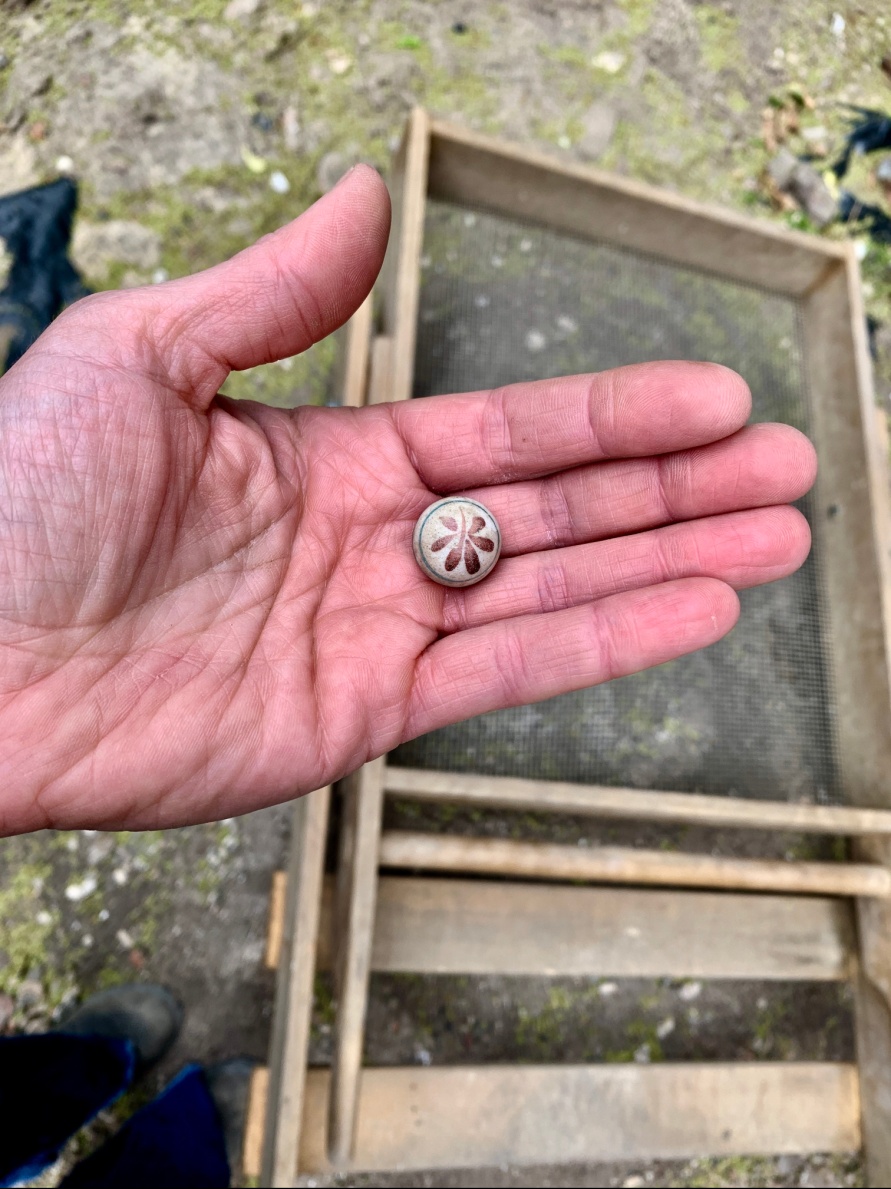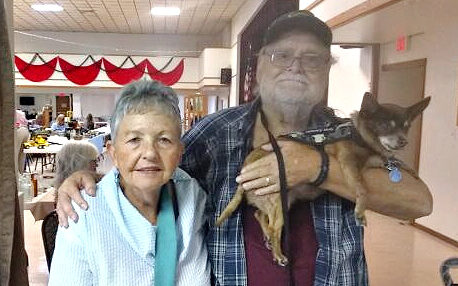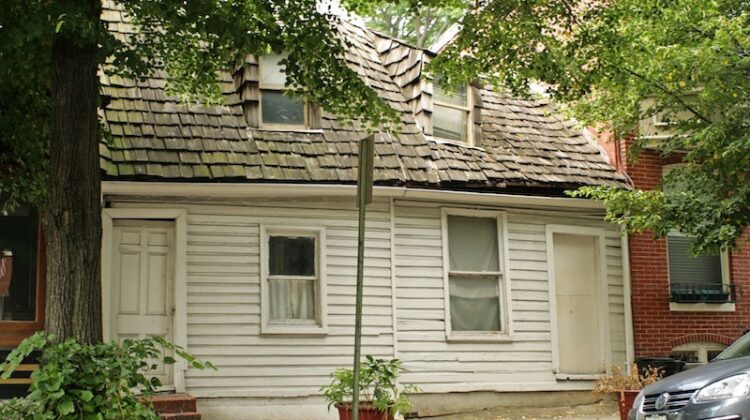
Baltimore Heritage[1] 612-614 S. Wolfe Street (2012) Exterior View
We recently had fun with the story “Limestone Marbles & The Eutaw Farm” (https://thesecretlifeofmarbles.com/limestone-marbles-the-eutaw-farm/)
In that post we told you about the significant public archaeology digs in the northeast of Baltimore, Baltimore County, Maryland.
These digs, to include Eutaw Farm, are the Herring Run Archaeology Project which has been led by the team of Dr. Lisa A. Kraus and Jason P. Shellenhamer. Lisa is a graduate of the University of Texas at Austin and she has worked as an archeologist for the Maryland Environmental Service/Maryland State Highway Administration since 2009. Jason is Co-founder and Project Director of the Herring Run Archaeology Project. He completed his Master’s of Applied Anthropology at the University of Maryland in 2004.
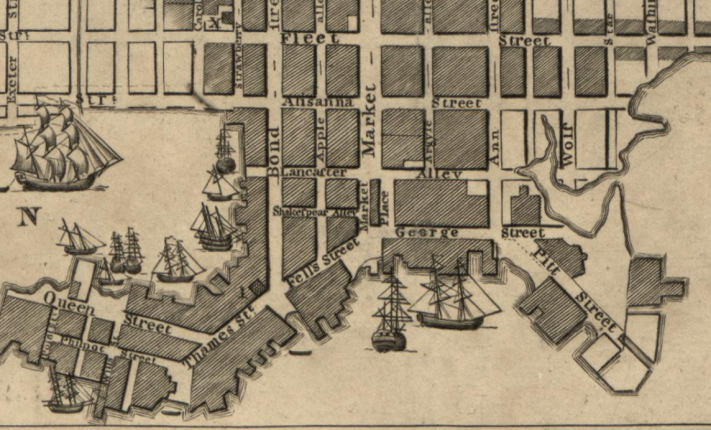
Library of Congress: Improved plan of the city of Balitmore, 1804[2]
From Eutaw Farm To The Caulker’s Houses
While researching Eutaw Farm we learned about the Caulker’s homes in Baltimore’s Fell’s Point which is “one of the oldest neighborhoods in Baltimore…. Fell’s Point was once a bustling shipbuilding port, and has served as the home to jazz singer Billie Holiday and abolitionist Frederick Douglass. Its visage has remained largely unchanged since its founding—picture Belgian block streets, waterfront restaurants and cozy boutiques just a few blocks east of the Inner Harbor.”[3]
Fell’s Point was established about 1763 and it was originally a busy shipbuilding hub because of its strategic location on the Patapsco River[4]. It is an extremely diverse neighborhood with a mixture of architectural styles. It boasts over 120 pubs! Fell’s Point is one of the first registered historic districts in the United States and is listed on the National Register of Historic Places.
Mary Zajac, Communications and Research Officer for Baltimore Heritage told us in an email that “the connection between Herring Run project and the Caulkers’ Houses in Fell’s Point is that Jason Shellenhamer and Lisa Kraus (of Herring Run Archaeology) have done projects at both sites. The two sites are not proximate of each other.” Still, they are only about three miles apart.
The Caulker’s Houses Location On Wolfe Street
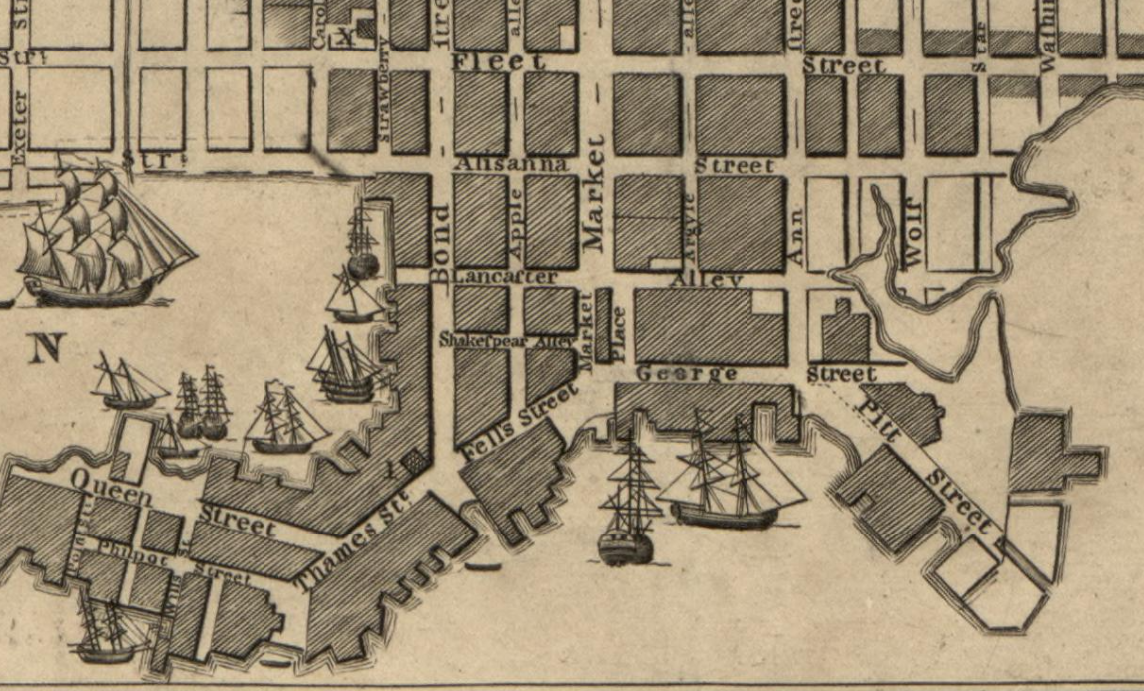
Library of Congress: Improved plan of the city of Balitmore, 1804[5]
The two adjacent wood frame caulker homes, at 612 and 614 South Wolfe Street have a remarkable history. You can see Wolf Street to the far right in this 1804 map of Fell’s Point. We have no idea when or why an “e” was added to Wolf. On this old map Wolf Street appears to end in the water. It almost does. This is the Inner Harbor which is an historic and lovely waterfront community with ships, restaurants, a number of those pubs such as James Joyce, Loch Bar, and Peter’s Poor House[6].
And yes, there are antique shops here too such as the Patapsco Market which is a flea market with over 600 vendors, The Antique Man, and The Parisian Flea. While we have never had the opportunity to try, we can’t imagine that you couldn’t find some marbles in one of the neat shops on the Inner Harbor.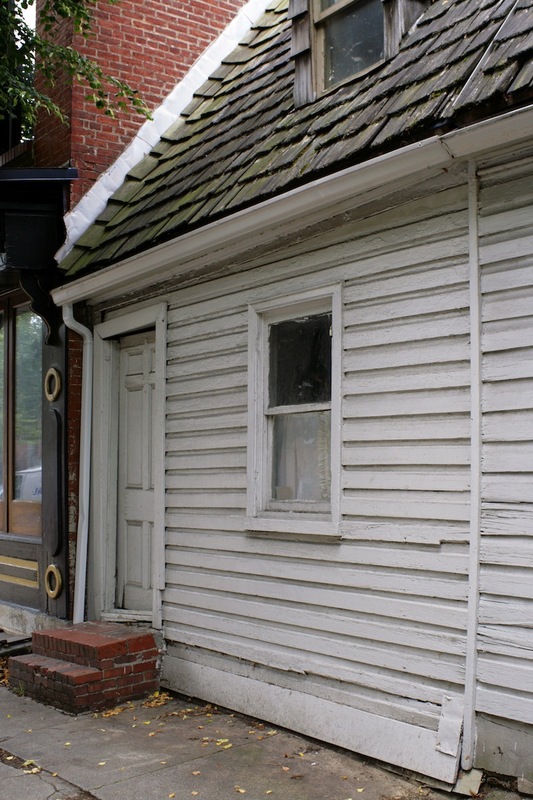
Detail of 612-614 S. Wolfe Street. ~ Source: Baltimore Heritage ~ Creator: Kurt Waters ~ Date: 2012[8]”
Two Sisters
One last thing about this 1804 map: it shows eleven ships in the Port and Inner Harbor. This is a critical fact. “Baltimore has a rich maritime history and was once a major shipping hub in the United States. The Port of Baltimore, established in 1706, became one of the nation’s busiest ports during the 18th and 19th centuries[7].”
If you were walking around in busy Fell’s Point enjoying the views, the bustle, boutiques, and looking for marbles in the antique shops and flea markets, then you would probably not even notice the tiny white framed houses at 612-614 South Wolfe Street. After all, as Stacy Montgomery tells us, “the houses at 612 and 614 South Wolfe Street are two of the smallest and oldest wooden homes remaining in Fell’s Point.
While the two tiny houses wedged tightly in between two large brick structures on either side are easy to miss, it is well worth the time to look at them carefully, and take a moment to read the heritage sign out front.
The Caulker’s Houses are also called “Two Sisters.” They “…likely date to 1797 – the same year that the U.S. Frigate Constellation was built in a Fell’s Point ship yard. Originally part of a building with four identical units, the remaining “Two Sisters” each stand just twelve feet wide and fifteen feet deep, with a single room on the first floor and a half story garret above.[9]”
Two Houses
The two houses were “built by Ann Bond Fell Giles as housing for the rapidly growing workforce in Fell’s Point, these houses are believed to be the sole survivors of their kind in Baltimore City. This type of residence was once the predominant housing stock of the middling class: caulkers, joiners, shopkeepers, blacksmiths, coopers, block makers, shipwrights, and sail makers.
In the 1980s, the buildings were acquired by the sisters Mary Leeke and Eleanor Marine Dashiell, … local preservationists, and great granddaughters of Fell’s Point sea captain Henry Dashiell. The houses are called the ‘Two Sisters Houses’ in their honor.”[10]
What Is A Caulker & What Do They Do?
In the past caulkers[11] (or calkers) were skilled workers who had a critical job which none of the 24 Fell’s Point shipyards could do without. Between 1784 and 1821 at least 800 ships were built at Fell’s Point and every single one of them had to have skilled caulkers aboard[12].
Simplistically, a caulker sealed the seams between the planks in the wooden ships so that the ship was as watertight as possible. Caulkers used cotton, oakum, and special caulking irons and mallets. Because of these skilled tradesman’s, work ships could maintain buoyancy and structural integrity. That is — the ship floated rather than sinking! They kept boats afloat.

Caulker’s Iron, Rope, & Assorted Tools Image Produced by Microsoft Copilot
The image above shows an historic caulker’s iron in the middle of the image. It is surrounded by more historic tools. Fiber rope like that shown are also critical for a sound caulking job!
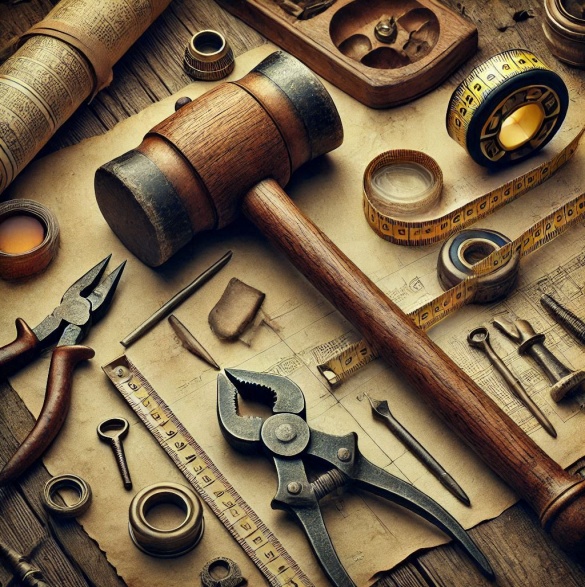 Caulker’s Hammer Image Produced by Microsoft Copilot
Caulker’s Hammer Image Produced by Microsoft Copilot
Wood Caulking
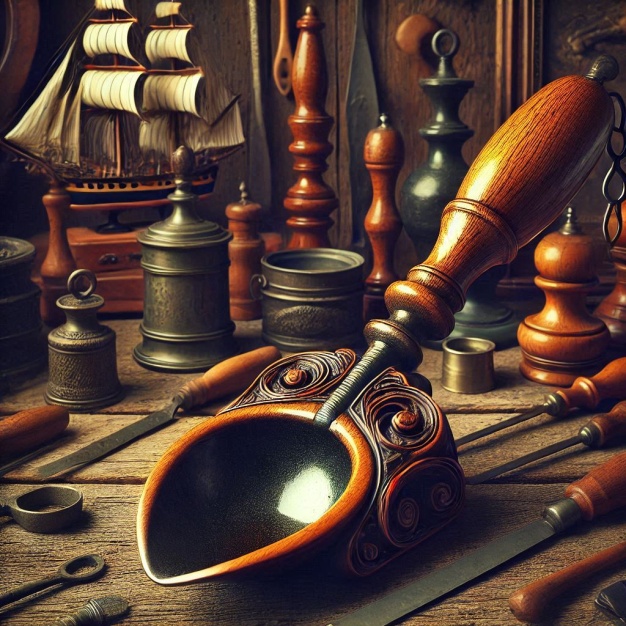
Caulker’s Ladle Image Produced by Microsoft Copilot
In the 18th and 19th centuries wooden ship caulkers were some of the highest paid workers aboard.
Wood caulkers caulking a ship ensured that the joins between all the planks of wood inside and outside were watertight. On a wooden ship caulkers used oakum to seal the joins between the planks[13].
The material to make oakum comes from old hemp ropes. At the start of the twentieth century, prison and workhouse inmates picked apart old hemp ropes to create oakum. Caulkers forced oakum between the planks using an iron and special caulking mallet. They then poured pitch or tar along the seam to seal it using a pitch ladle[14]. All of this skilled work, which is still done today to restore wooden ships, did seal the ship and it kept water from pouring in.
The Fell’s Point Caulkers: Proficient Freed Blacks
Danielle Olson, in her succinct and compelling story “The Bay of Opportunity and Hope,” explains how the Chesapeake Bay has always been a very special place for Black Americans. She also explains that the freed Blacks created an iconic legacy which still lingers in the bays, inlets, and waterways today.[15]
In the early 1800s seafaring jobs were some of the few careers that employed freed Blacks. An expansion of the shipping industry following the Revolutionary War created ample job opportunities, but the low wages and lack of independence deterred white people and left a void to be filled by Black workers. For newly freed slaves, however, the steady income and worldly work was an opportunity for a better life.
By 1803 about 18 percent of America’s seafaring jobs were freed Blacks. Black workers filled every type of job in the industry.
…Nearly every ship caulker in the famed Fells Point shipyard in Baltimore was Black, and they earned one of the highest paid wages for a skilled worker in the shipyard. Free Black seamen were so commonplace that Frederick Douglass[16], a young Maryland native, escaped to freedom by donning the striped uniform of a seamen as he traveled north.[17]
How Could A Black American Gain Their Freedom In The 19th Century?
Olson seems to be speaking about freed slaves. Yes, this is one part of the story. Some enslaved people were freed by their owners through a process called manumission. This process was sometimes done by the Black’s owner in his will but it could also be done through a legal document.
Some enslaved Blacks bought their own freedom or they were freed when purchased by others who granted them manumission.
Like Frederick Douglass some Blacks escaped to freedom. After his escape in 1838, Douglass was employed in the shipyards of Fell’s Point, where he learned the trade of caulking. This experience was part of his journey towards gaining literacy and eventually escaping to freedom[18]. There is no doubt that his work as a caulker contributed to his advancement as a leader and abolitionist.
Some Blacks served in the Revolutionary War and they were freed for their service. Free African American communities and churches often provided support and resources to help others gain their freedom.
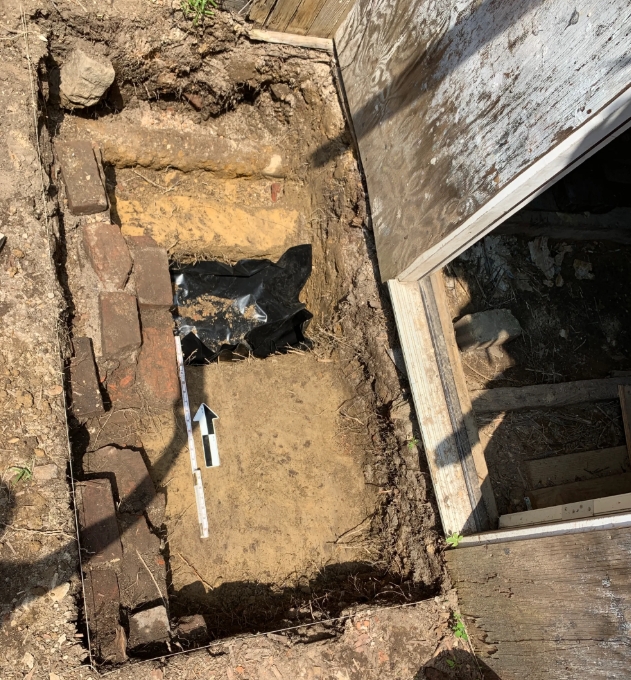
Courtesy of The Herring Run Archaeology Project: The original western foundation of 612 Wolfe Street[19]
Now Back To The Free Black Caulkers Homes In Fell’s Point
Courtesy of The Herring Run Archaeology Project: Unglazed German “Daisy Wheel” porcelain marble from the Caulkers’ Houses.
The Caulkers And Their Families: Good Times & Bad
We have noted in this post that the Herring Run Archaeology Project is led by the wife and husband team of Dr. Lisa A. Kraus and Jason P. Shellenhamer. We have also explained that they have worked on digs and projects both at Eutaw Farm and at the Caulkers homes.
In Partnership with the Friends of the Ship Caulkers’ Houses and the Society for the Preservation of Federal Hill and Fell’s Point, the Herring Run Archaeology Project conducted a community archaeology program at the Caulkers’ Houses in 2019 and 2020, in advance of the restoration of the houses[20].
History tells us that from the early to the mid 1800s free black caulkers and their families lived in the little frame houses at 612 and 614 South Wollf[e] Street. We have seen how important the work that the caulkers did in the shipyards was to the Fell’s Point, Maryland, and American economies at that time.
Free Blacks were indispensable to the shipping industry in the early 1800s and that caulking was a difficult and precise job which required skill, talent, specialized tools, and experienced individuals to do the job right the first time. We also know that by this time the caulkers and their families belonged to what has been described as the “middling” class.
The digs at the homes, which have included the privy (You Dug It Up Where? https://thesecretlifeofmarbles.com/you-dug-it-up-where/), have given us tangible shards of ceramic, straight pins, coins, and gaming tokens from beneath the floorboards, and so many more artifacts. Each and every artifact dug, coupled with a study of the archives and history, gives a wealth of information about these special and unique tradesmen and their families in the early 19th century.
Flashpoint
The Black caulkers formed the Caulkers Association by 1838 “…to negotiate wages and working conditions with the powerful Baltimore Shipwrights Association, an organization of master shipbuilders and carpenters. As a result, despite numerous challenges, African Americans dominated the caulking industry in the early part of the 19th century.”[21]
Of course, the Black caulkers could not hold onto their near-monopoly of the trade. The Herring Project explains that in 1858 and 1859, a white working-class gang calling themselves the Tigers broke the African-American monopoly on caulking jobs in an explosion of violence and harassment that came to be known as the Caulker Riots[22].
An economic downturn, riots, racial violence by White shipyard workers and others against the Black caulkers, and eventual loss of Black jobs were all a part of the Fell’s Point scene from about 1858 until after the Civil War in 1866. But we just wonder. Where exactly did those White Tigers learn how to caulk; did they have the proper tools and experience? We wonder how the wooden shipbuilding and ship overhaul fared in the Harbor during this period?
At any rate, the little caulkers’ homes stood firm throughout these turbulent times. And with the situation in mind, the Herring Run Archaeology Project asked the question “… what was life like for the ship caulkers at the household level? What did they do at home with their families and friends, and how did these forces shape their day-to-day lives? This is where the archaeology comes in.”
Dug Treasures
For nearly a quarter century, in our book The Secret Life of Marbles Their History and Mystery and here in our eMagazine (see https://thesecretlifeofmarbles.com/invisible-children/ ) we have lamented the absence of children as reported in official archaeology dig reports. The situation has been getting better for a number of years, but for too many years in archaeology it was as if children did not exist in the culture studied!
So you can imagine how happy we were when we read these very first lines from a Herring Run Archaeology report: children’s toys are delightful to find, since they are instantly recognizable and retain much of their charm, even after spending hundreds of years in the dirt.[23]”
Getting The Artifacts Out Of The Ground & In Hand
We wanted to learn about these toys, to include marbles, and we wanted to share their story with you. Before we discuss this unglazed German “Daisy Wheel” China marble, we want to call attention to the rocker screen in the background. The simple shaker or rocker screen, with sizes of mesh ranging from 1/4” to 1/16,” is used to sift through midden and soil looking for small artifacts.
Generally, archaeologists, trained volunteers, and possibly students, dig a unit[24] or defined spot and remove soil layer by layer. Larger artifacts are found, bagged, and tagged here for later lab analysis, special testing as needed, assessment, and documentation.
But soft plastic buckets or wheel barrows of soil are removed and sent to the person using the shaker so that tiny artifacts can be found. As a volunteer on Santa Rosa Island, Florida, one summer Larry worked the shaker and he identified a tiny silver wire from the 1500s which was used in jewelry making. And, depending on the site, you find beads, tiny doll’s buttons, animal teeth, seeds and pits[25], and small fish, and hollow bird bones left from food preparation. The only place Larry ever found a marble on a dig is in the unit itself.
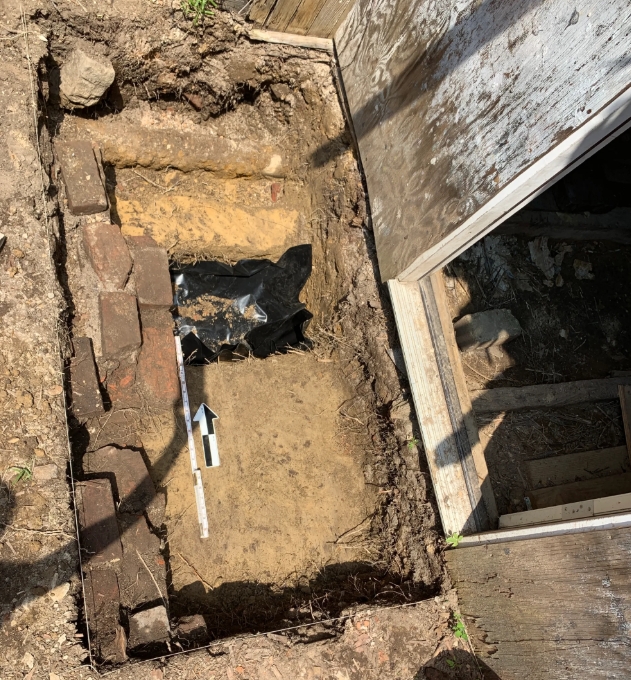
Marbles From The Caulker’s Houses
Generally marbles of the size dug at the Caulker’s Houses (probably about ¾”) would be seen in the dig strata or in the bucket used to move soil from the dig unit, like this one at the Caulker’s houses, to the screen. Still, screening can be one of the most fun jobs on the dig site!
The Herring Run Archaeology Project, in the story “Small Finds, Big Stories: Two Marbles from the Caulker’s Houses” (May 27 2019), tells us that this China treasure was found in the 2019 dig at the houses.
German Daisy Wheel & Time Markers
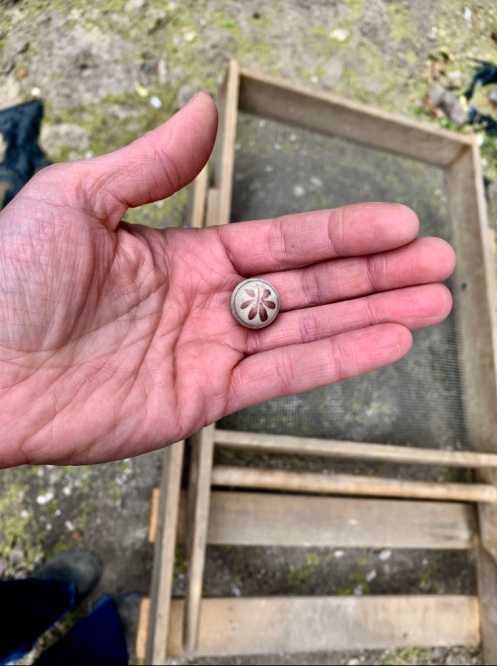
Herring Run Archaeology Project: Unglazed German “Daisy Wheel” porcelain marble from the Caulkers’ Houses
In this story the archaeologists focus on this beautiful porcelain or ceramic marble as a time marker.
We always refer to Paul Baumann’s Collecting Antique Marbles Identification and Price Guide when we need to learn more about antique ceramic, stone, clay, or glass marbles. The marble dug at Fell’s Point has six red “leaves”.
Baumann writes: “Sometimes 4 to 13 brush-strokes radiated from the central point or dot [a point in this case], forming a daisy wheel or pinwheel….Pinwheels date from the early years of china marble production and have been found in privies dating from 1850 – 1860.” (pages 35-26)
So, yes, these marbles are excellent time markers. Of course, we can’t say with 100% certainty that the children of freed black’s played with this particular marble, but it is highly probable. Remember, they lived at the time period matches.caulker’s
Remember, the caulker’s lived at 612 – 614 South Wolf Street primarily in the immediate pre-Civil War era from about 1838 – 1858[1] so the time period matches.
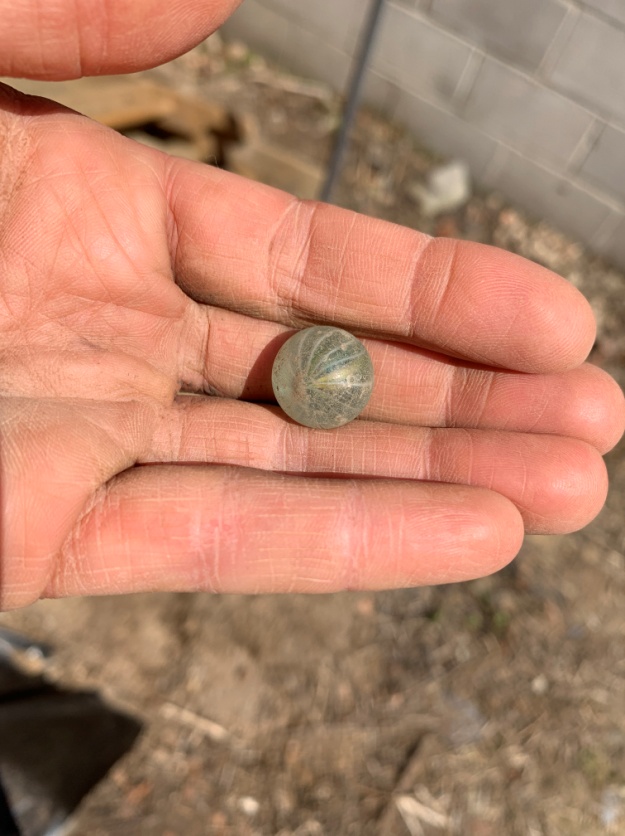
Herring Run Archaeology Project: Early German-made glass marble from the Caulkers’ Houses.
German Handmade Glass Swirl
Again, Baumann is an excellent reference. His Chapter 4 is “German Marbles” pp. 37 – 66. And we have written extensively about German glass marbles. See, for example, “The Lauschaer Glashütte and the Origins of Modern Glass Marbles” and “Lauscha and Ilmenau Marbles”.
While we would love to hold this marble and determine exactly what kind of swirl it is (and we know some of you would love to polish it!), we will just settle for what the list Diagnostic Artifacts in Maryland tells us.
The 19th century handmade German glass swirl marbles date to ca. 1854. They have “transparent glass body with variously colored twisted glass threads and ribbons. These … marbles have cut off marks at opposite ends[27].” Some researchers date German export to as early as 1846. German export of glass marbles was effectively over by World War I and 1920 is a generally agreed-upon date.
And again the time marker holds. Both of these treasures, the China Daisy or Pinwheel and the German Handmade Glass Swirl, could have been played with by the children of the Black caulkers.
Marbles Are Also Socioeconomic Markers
In their story “Small Finds, Big Stories: Two Marbles from the Caulkers’ Houses,” the writers note that:
“The children who lived in Fells Point in the 1850s and 1860s were born on the cusp of the Industrial Revolution, before children’s toys were a significant part of the economy. During the first part of the 19th century, toys sold in stores were unattainable for most children, but by the 1850s, that was beginning to change. As manufacturing techniques became more sophisticated, a wider variety of toys were easier and cheaper to make, and thus easier and cheaper to obtain.
Although they had no idea that they were participating in the global economy, the children who lived at the Caulkers’ Houses in the 1860s were making choices as toy consumers (or perhaps they were playing marbles “for keepsies” and were especially successful), and influenced the choices of other children, toy sellers, and manufacturers with their preferences.”
In fact, the children and the families of the caulkers were also participating in and therefore extending a deep and abiding social change in America. For one thing the children were recognized as individuals. Children. Children who enjoyed “bought” toys and marbles. Children who played. Not just little adults.
Caulkers, Block Makers, Coopers and Joiners
For another thing, they could and did participate in the economic pulse of the vibrant Fell’s Point in the 1840s – 1860s. And they could participate because their fathers were skilled and experienced caulkers. Other children in Fells Point had fathers who were ship’s block makers who had the historical job of making and then maintaining wooden blocks used in the ships rigging[28]. Other fathers were coopers who made wooden barrels and casts to store the ships’ water, food, and supplies.
Ship’s joiners were highly skilled carpenters who worked on board ships. Their primary job was to construct and repair wooden furniture and fixtures on board the ship, such as bunks, tables, and cabinets. They also worked on the ship’s interior woodwork, ensuring everything was sturdy and functional. Joiners were essential for maintaining the ship’s living quarters and other wooden structures, contributing to the overall seaworthiness and comfort of the vessel[29].
Others working and living the American dream in Fell’s Point just before the Civil War were shopkeepers, blacksmiths, shipwrights, and sail makers. It was truly an iconic time in the history of Maryland and America.
The marbles are both time markers and socioeconomic markers because both decorated China and glass were relatively the more expensive marble on the market at the time. We know that a limestone marble was dug at the Caulkers homes, and these too were often from Germany. But the fact that the children of the skilled workers could afford expensive German imported marbles speaks volumes about their families social status.
Caulk The Deck & Seal It
“How lucky I am to have something that makes saying goodbye so hard.” – A.A. Milne, Winnie-the-Pooh
The next time you have the good fortune to visit Fell’s Point do enjoy the sights and sounds, the views of the ships and harbor, antique shops, boutiques and restaurants. There are so many places to hang your hat such as the Inn at Mary’s Land Farm, the Indigo, Sagamore Pendry, and so many more places for any taste and wallet.
But do walk slowly by 612-614 South Wolfe Street and stop to read the heritage marker. These old home are unique in Baltimore and, indeed, to America. They sheltered a free Black people who worked hard with specialized skills and tools to build a better life for themselves, their children, and grandchildren.
And again through it all we find toys. Marbles. Little treasures that were played with by tiny hands. We have written about marbles being present in human history since the Paleolithic, Colonial, Civil War, “Wild West”, Depression, etc.
Well, marbles were also a real and integral part of life in Fells Point in the booming, often chaotic, and pivotal times of the early 19th century. Freed Blacks accomplished something which must never be forgotten. They were skilled, dedicated to their work and families, and yes, their children had some of the most expensive marbles available on the market at the time.
“Don’t cry because it’s over, smile because it happened.” – Dr. Seuss
References
- 612-614 S. Wolfe Street (2012) Exterior View of 612-614 S. Wolfe Street ~ Source: Baltimore Heritage ~ Creator Kurt Waters ~ Special thank you to Mary Zajac, Communications and Research Officer Baltimore Heritage See Stacy Montgomery, “Caulker’s Houses,” Explore Baltimore Heritage, accessed December 13, 2024, https://explore.baltimoreheritage.org/items/show/139.↑ [1] The Ship Caulkers’ Houses. Digital Brochure. Pdf. Shipcaulkers.org. You might also want to check out the China marble dates in more detail at “Table 1. Date ranges & characteristics of marble types” Maryland Patterson Park & Museum; Maryland Archaeological Conservation Laboratory Diagnostic Artifacts in Maryland @ https://apps.jefpat.maryland.gov/diagnostic/SmallFinds/index-SmallFinds.html. We would be remiss if we didn’t mention the two “marble history & archaeology pioneers” Jeff Carskadden and Richard Gartley. Especially informative for this post are: Jeff Carskadden and Richard Gartley. “A Preliminary Seriation of 19th-Century Decorated Porcelain Marbles,” Historical Archaeology, 24: 55 – 69, 1990 & Richard Gartley and Jeff Carskadden Colonial Period and Early 19th-Century Children’s Toy Marbles; History and Identification for the Archaeologist and Collector. The Muskingum Valley Archaeological Survey, Zanesville, Ohio, 1998. Baumann has a reference list with a number of their studies on pps. 202-203. If you do get a hold of a digital copy of their “Seriation” study then we really recommend that you print a copy for your marble reference shelves.
- Warner & Hanna. Improved plan of the city of Baltimore. [Baltimore, 1804] Map. Retrieved from the Library of Congress, <ww.loc.gov/item/77691636/> ↑
- Fell’s Point Baltimore Neighborhood Guide | Visit Baltimore 12/18/2024 ↑
- “Patapsco” sounds to us like a very unusual name which is both hard to spell and to pronounce. The name “Patapsco” comes from the Algonquian word “pota-psk-ut”, which translates to “backwater” or “tide covered with froth”. The Patapsco River, which flows into the Chesapeake Bay, was named by the Native American tribes who originally inhabited the area. Patapsco River – Wikipedia 12/21/2024 ↑
- Warner & Hanna. Improved plan of the city of Baltimore. [Baltimore, 1804] Map. Retrieved from the Library of Congress, <ww.loc.gov/item/77691636/> ↑
- 7 Best Bars And Lounges In Inner Harbor | OpenTable & Peter’s Pour House | Corner of Water & Grant Streets 12/21/2024 ↑
- Port of Baltimore – Wikipedia 12/21/2024 ↑
- Stacy Montgomery, “Caulker’s Houses,” Explore Baltimore Heritage, accessed December 13, 2024, https://explore.baltimoreheritage.org/items/show/139. ↑
- https://mdhistoricaltrust.wordpress.com/2015/02/24/the-two-sisters-houses-a-tangible-link-to-baltimores-african-american-labor-history/ (12/19/2024) While the photographs in tour story are from 2012, this site is the online post “The Two Sisters’ Houses: A tangible link to Baltimore’s African American labor history” By Tyler Anthony Smith February 24, 2015. Smith’s story explains that …the “Two Sisters” houses are a physical remnant of [the] unique Baltimore history. A grant from the African
American Heritage Preservation Program (AAHPP), a partnership of the Maryland Commission on African American History and Culture and the Maryland Historical Trust, has made it possible for the Preservation Society and the Dell Corporation to continue the stabilization of the structures over the past two years, an effort which has included weatherproofing the structure and constructing an ingenious and minimally invasive interior support system. The grant also allowed for archeology done by the Ancient Studies department at the University of Maryland Baltimore County. This AAHPP project has helped to preserve these fragile structures, the first step toward articulating and interpreting the story of Baltimore’s African American laborers.” Importantly, you get to see inside the homes as the preservation was underway. See “The Two Sisters Houses: A Tangible Link to Baltimore’s African-American Labor History” by Tyler Anthony Smith April 17, 2015 for even more detailed inside views @ https://mdhistoricaltrust.wordpress.com/2015/02/24/the-two-sisters-houses-a-tangible-link-to-baltimores-african-american-labor-history/ 12/21/2024 ↑ - It’s odd, but we have seen a number of different street numbers for these old frame houses. The story we cite here uses 614 South Wolfe Street. We have also seen the address reported as 602 – 604. We’re unsure why. “Two Sisters Wooden Artisan Houses” @ Historic Fell’s Point Trail – Two Sisters Wooden Artisan Houses 12/22/2024↑
- Note that “there are two types of caulker; a wood caulker who caulks joints in wood and an iron caulker who caulks metal joints.” See: Sea Your History – Caulkers 12/22/2024 ↑
- “Fells Point Historic District” Trust for Architectural Easements Preserving Historic Neighborhoods @ Fells Point Historic District – & Rediscover “Stephen Lampredi: The Legacy of Fell’s Point Shipbuilding” The Society for the Preservation of Federal Hill & Fell’s Point” @ The Society for the Preservation of Federal Hill & Fells Point 12/22/2024 ↑
- Sea Your History – Caulkers 12/22/2024 ↑
- Sea Your History – Caulkers (12/22/2024) Sticky pitch was harvested from pine trees. The resin was heated or “cooked” until it became thick and tar-like. This was then poured onto the board seams with the ladle. When it cooled there was a durable waterproof seal. ↑
- Danielle Olson, “The Bay of Opportunity and Hope.’ Smithsonian Museum of Natural History. @ https://ocean.si.edu/human-connections/history-cultures/bay-opportunity-and-hope 12/17/2024 ↑
- See Douglass, F., & Foner, P. S. (1950). The life and writings of Frederick Douglass, Volume 1: Early Years, 1817-1849. International Publishers. ↑
- Olson. You might also want to see Life of George Henry Together with a Brief History of the Colored People in America: Electronic Edition. Henry, George, b.1819 @ https://docsouth.unc.edu/neh/henryg/henryg.html 12/23/2024 ↑
- Cassie, Ron. “From Fells To Freedom Celebrating Frederick Douglass’ 200th Birthday.” February 2018. @ https://www.baltimoremagazine.com/section/historypolitics/frederick-douglass-historic-fells-point-walking-tour/ 12/23/2024 ↑
- “Caulkers’ Houses: Update for May 18th & 19th”. May 20, 2019. ↑
- https://herringrunarchaeology.org/2019/06/05/caulkers-houses-update-for-june-1-2/ 12/23/2024 ↑
- https://herringrunarchaeology.org/2019/06/05/caulkers-houses-update-for-june-1-2/ 12/23/2024 ↑
- At the same time … the economy had turned sour, immigration had increased, and political competition had intensified between the American Party, the Democratic Party, and other political factions. In this increasingly volatile environment, the black caulkers of Baltimore came under attack in the caulker riots of 1858-1859 and then again in 1865, when white shipyard workers went on strike and demanded that black caulkers be fired. One month after the strike began, shipyards in East Baltimore agreed to fire black caulkers by the spring of 1866. See ©Copyright 2004 MSDE/Reginald F. Lewis Museum of Maryland African American History and Culture 26-4 Pdf ↑
- “Small Finds, Big Stories: Two Marbles from Caulkers Houses.” Herring Run Archaeology Project. May 27, 2019. ↑
- Microsoft Copilot tells us: “In archaeology, a “unit” refers to a specific section or portion of an excavation site. This unit is typically a square or rectangular area that’s been marked out on the ground for systematic digging and analysis. Archaeologists divide a site into units to keep track of where artifacts are found and to document the context of these findings accurately. Each unit is excavated layer by layer, which helps archaeologists understand the chronological sequence of events at the site. It’s a bit like unearthing a historical puzzle, where each piece must be carefully recorded to preserve the story of the past.” ↑
- Along the way, Larry learned that under the right environmental conditions peach pits can easily survive three centuries in the ground or more! ↑
- The Ship Caulkers’ Houses. Digital Brochure. Pdf. Shipcaulkers.org. You might also want to check out the China marble dates in more detail at “Table 1. Date ranges & characteristics of marble types” Maryland Patterson Park & Museum; Maryland Archaeological Conservation Laboratory Diagnostic Artifacts in Maryland @ https://apps.jefpat.maryland.gov/diagnostic/SmallFinds/index-SmallFinds.html. We would be remiss if we didn’t mention the two “marble history & archaeology pioneers” Jeff Carskadden and Richard Gartley. Especially informative for this post are: Jeff Carskadden and Richard Gartley. “A Preliminary Seriation of 19th-Century Decorated Porcelain Marbles,” Historical Archaeology, 24: 55 – 69, 1990 & Richard Gartley and Jeff Carskadden Colonial Period and Early 19th-Century Children’s Toy Marbles; History and Identification for the Archaeologist and Collector. The Muskingum Valley Archaeological Survey, Zanesville, Ohio, 1998. Baumann has a reference list with a number of their studies on pps. 202-203. If you do get a hold of a digital copy of their “Seriation” study then we really recommend that you print a copy for your marble reference shelves. ↑
- Richard Gartley and Jeff Carskadden Colonial Period and Early 19th-Century Children’s Toy Marbles; History and Identification for the Archaeologist and Collector. The Muskingum Valley Archaeological Survey, Zanesville, Ohio, 1998. ↑
- http://www.marinelives.org/wiki/Blockmaker?form=MG0AV3 12/27/2024 ↑
- https://www.familyresearcher.co.uk/glossary/Dictionary-of-Old-Occupations-jobs-beginning-J.html?form=MG0AV3 & https://seayourhistory.org.uk/content/view/91/178/?form=MG0AV3 12/28/2024 ↑

